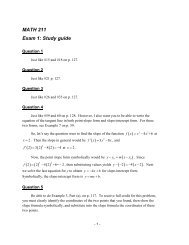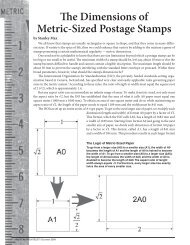Radian Measurement: - Metric Philatelist
Radian Measurement: - Metric Philatelist
Radian Measurement: - Metric Philatelist
You also want an ePaper? Increase the reach of your titles
YUMPU automatically turns print PDFs into web optimized ePapers that Google loves.
Figure 5: Fractions of a circle are equivalent to τ-radians. Courtesy Michael Hartl, The Tau Manifesto<br />
(2011). In http://tauday.com.<br />
How to put this new method into practice<br />
Of course, the conventional method continues to use -radians, and not -radians.<br />
Unquestionably, I believe, the force of history causes the problem. For perhaps thousands of<br />
years, , which is defined in terms of diameter, has been used as the fundamental circle<br />
constant. And the definition that 180 rad has been used since 1873. If we could just start<br />
from scratch, then the logic of using , which is defined in terms of radius, would surely be used<br />
as the fundamental circle constant instead of the diameter-defined . In that case, textbooks<br />
would be writing that 360 rad , and that would make things a whole lot simpler.<br />
All of this may be well and good. But the influence of history persists, so what should<br />
students do when confronting the inefficiency of -radians Answer: Either disregard<br />
everything that I have just written in this paper and keep using the formulation that 180 rad .<br />
Or, better yet, continue to use the conventional definition of radians in terms of — since that<br />
is what all the textbooks do — but when you start getting confused and want to simplify things,<br />
just divide by 2. Once you have divided by 2, -radians becomes -radians. So, for example,<br />
<br />
180 rad = rad — one-half of a turn. The conversion is that simple.<br />
2<br />
- 7 -<br />
Copyright © 2011, 2012 Stanley Max





